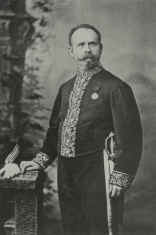Franz Simandl

Franz Simandl (August 1, 1840 – December 15, 1912) was a double-bassist and pedagogue from Austria-Hungary most remembered for his book New Method for String Bass, known as the "Simandl book", which is to this day used as a standard study of double bass technique and hand positions.[1]
His approach uses the first, second, and fourth fingers of the left hand (the third and fourth operating together as one digit) to stop the strings in the lower register of the instrument and divide the fingerboard into various positions.
The second volume of the method looks at the use of thumb position using the thumb, first, second and third fingers, to play solo, high register work and again dividing the fingerboard up into a concept of positions. The second volume also delves extensively into the playing of harmonics.
Simandl's "New Method" of playing, originally published in 1881, is still common among classical double bassists,[1] American String Teacher 46:4 pp59-60</ref> Modern adaptations of, extensions to, and challenges to Simandl doctrines are acknowledged.[2][3][4][5]
Simandl studied at the Prague Conservatory with Josef Hrabě before becoming the principal bassist in the Vienna Court Opera Orchestra. He was a Professor of double-bass at the Vienna Conservatory from 1869 to 1910.[6] His pupils include many of the leading bassists of his time such as Ludwig Manoly, who moved to New York City to become principal bass of the New York Philharmonic and was an influential teacher.
The Simandl "family tree" of bass pedagogues extends for many generations. Prominent bassist/educators who can trace their lineage directly back to Simandl include Adolf Mišek, Richard Davis, Mark Dresser, Joseph Guastafeste, Greg Sarchet, Gary Karr, Hermann Reinshagen, Karl E. H. Seigfried, Ludwig Streicher, Bertram Turetzky, and Frederick Zimmermann.
Notes
[edit]- ^ a b Leavitt, Todd, 1997 The state of contrabass instruction at selected colleges and universities in the United States of America, doctoral thesis
- ^ Crawford, Tim 2009 Solo bassists from the start! The application of contemporary bass pedagogy concepts to beginning string class instruction, in American String Teacher Magazine 59:3 pp 40-43
- ^ Karr, Gary 1995 Karr talk: Simandlites, beware!, in Bass World - The Journal of the International Society of Bassists 20:2 p20
- ^ Gale, T. B. and Morton, M. A. 2001 Triumvirate for the 21st century: 'Simandl-Plus' system combines closed-hand, open-hand and thumb positions, in Double Bassist Magazine 18 pp 72-73
- ^ See also François Rabbath
- ^ Biography of Simandl in English edition of "New method for the double bass", Book 1, edited by Lucas Drew, New York:Carl Fischer, 1964
References
[edit]- Simandl, Franz (1956). 30 studies for string bass. LCCN 85751475
- Simandl, Franz (1957). Gradus ad parnassum : 24 studies for string bass. LCCN 85752065
- Simandl, Franz (1968). New method for string bass. LCCN 97706725
External links
[edit]- Prague School Family Tree at the Wayback Machine (archived February 19, 2008)


 French
French Deutsch
Deutsch